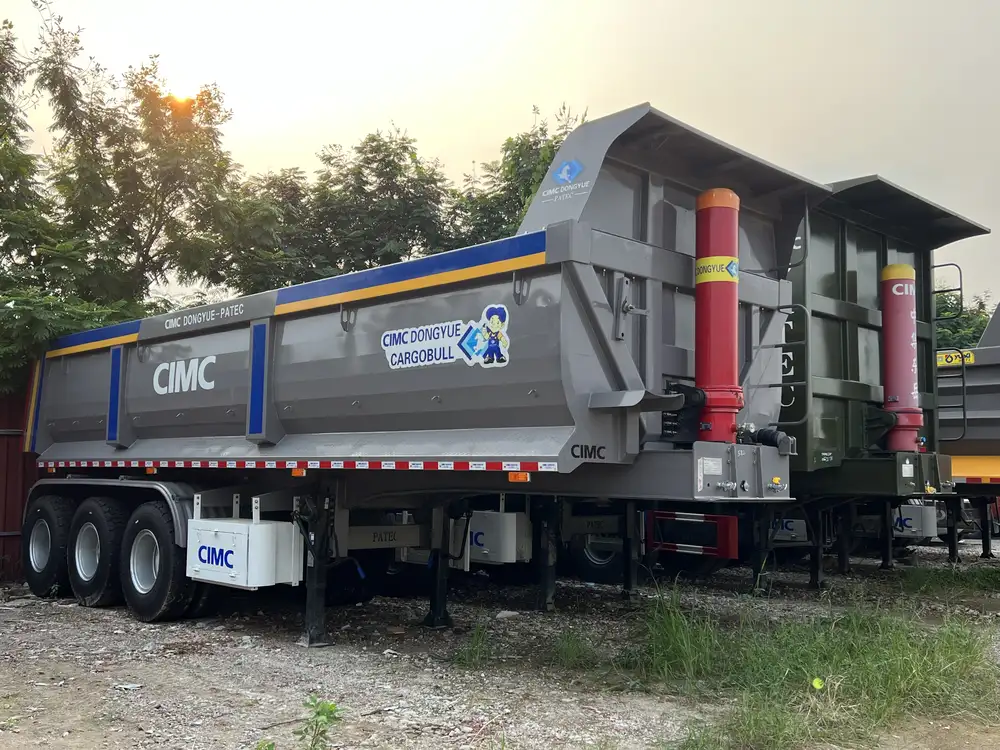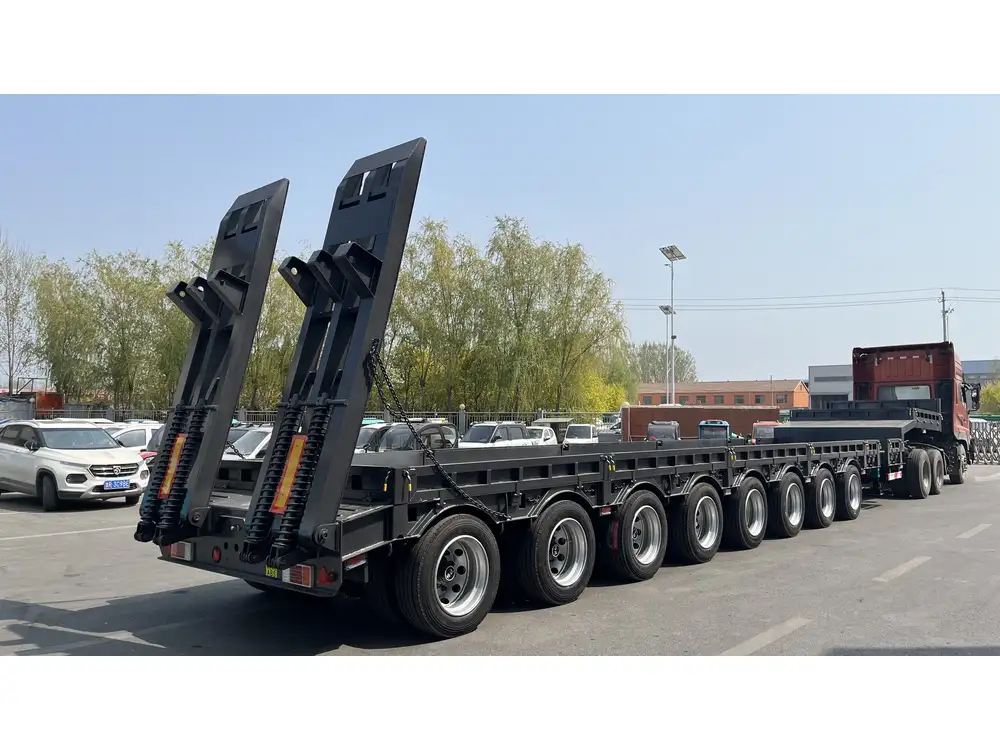The Definition of a Semi-Trailer
A semi-trailer is a type of trailer without a front axle, designed to be towed by a tractor unit. The weight distribution is such that a significant portion of the trailer’s weight rests on the tractor, making semi-trailers crucial for long-haul transport logistics. These vehicles are essential in the freight transport sector, seamlessly moving goods across vast distances.
Types of Semi-Trailers
Semi-trailers come in various designs tailored to specific cargo needs. Here are some common types:
| Semi-Trailer Type | Primary Use |
|---|---|
| Flatbed | Heavy equipment, machinery, and lumber |
| Refrigerated (Reefer) | Perishable goods |
| Tanker | Liquid goods like fuel or chemicals |
| Enclosed (Dry Van) | General cargo |
| Stepdeck | Over-height loads |

What’s the Longest Semi-Trailer?
The longest semi-trailer currently permitted varies by jurisdiction but can reach impressive lengths. In North America, the typical maximum length allowed for a semi-trailer is 53 feet. However, specialized trailers, such as stretch trailers or modular trailers, can extend significantly longer.
A Closer Look at Length Regulations
North America
- 53 Feet: Standard for most semi-trailers in the United States and Canada.
- Special Permits: Some states allow lengths beyond 53 feet for specific loads, often subject to additional regulations.
Europe
- European Regulations: The maximum length is typically 16.5 meters (approximately 54 feet), aligning closely with North American standards but can vary by country.
These regulations are influenced by the need for safety, road infrastructure, and environmental concerns. Regulatory bodies ensure that while maximizing trailer length can enhance load capacity, it doesn’t compromise roadway safety and efficiency.
The Innovative Side of Long Semi-Trailers

Technological Innovations
With advancements in engineering and materials, the design of semi-trailers continues to evolve. Here are some noteworthy innovations:
Lightweight Materials: Use of materials such as aluminum or composite materials lowers the overall weight of the trailer, allowing for increased payload without exceeding weight limits.
Aerodynamic Designs: Improving the shape of trailers can significantly reduce drag, leading to better fuel efficiency. Enhancements like side skirts and aerodynamic tails have become prevalent features.
Smart Trailers: Implementation of IoT sensors helps monitor cargo conditions, providing real-time data on temperature, humidity, and structural integrity limits. This is especially important for temperature-sensitive cargo such as food products.
Comparison of Standard vs. Long Semi-Trailer Features
| Feature | Standard Semi-Trailer | Long Semi-Trailer |
|---|---|---|
| Maximum Length | 53 feet | Up to 80 feet (or more) |
| Payload Capacity | Approximately 26,000 lbs | 40,000 lbs or more |
| Maneuverability | High | Moderate due to length |
| Regulatory Permits | Standard | Requires additional permits |
The Economic Implications of Using Longer Semi-Trailers

Cost-Efficiency and Payload Optimization
Utilizing longer semi-trailers can significantly enhance logistics efficiency:
Increased Payload: Longer trailers can accommodate more goods, leading to fewer trips and lowered transportation costs per mile.
Fuel Efficiency: Depending on design, longer trailers can be engineered for improved aerodynamics, contributing to reduced fuel consumption.
Environmental Considerations
While longer semi-trailers can optimize infrastructure and costs, they can also impact the environment. The reduction in trips required can lead to lower carbon emissions overall. However, it is crucial to balance these advantages with the potential wear on road infrastructures and increased safety risks associated with longer loads.
Safety Concerns with Longer Semi-Trailers

Maneuverability Challenges
One of the significant concerns with longer semi-trailers is their maneuverability. The turning radius increases, potentially complicating navigation in urban settings or tight spaces.
Stability and Road Safety
Long semi-trailers can face greater challenges related to stability, especially in adverse weather conditions. Factors such as wind resistance, weight distribution, and braking distances become even more critical. Proper training for drivers and adherence to safety protocols are essential for mitigating these risks.
Innovative Safety Features
To combat these issues, manufacturers are developing and incorporating advanced safety technologies. Some innovations include:
Electronic Stability Control (ESC): This system helps prevent skidding and loss of control during abrupt maneuvers.
Advanced Braking Systems: Adaptive braking systems that respond to different load weights can provide better stopping power.
Blind Spot Monitor Systems: Technologies that alert drivers to potential hazards that may not be visible while changing lanes or making turns.

The Future of Longer Semi-Trailers
Legislative Developments
As the demand for efficiency in freight transport increases, lawmakers are continuously revisiting regulations surrounding trailer lengths. Potential future changes might include:
Increased Length Limits: Certain states and regions are exploring the possibilities of extending length caps, particularly for eco-friendly options.
Incentives for Clean Technology: As green technology becomes a pressing issue, incentives may be introduced for deploying longer trailers equipped with sustainable features.
The Rise of Modular Load Systems
One promising development in the field of semi-trailer design is modular loading systems. By allowing multiple smaller loads to be combined into one longer unit, logistics companies can maximize efficiency without compromising safety or regulatory compliance.
Example of Modular Trailer Configurations:
- Ship Load Systems: Using container-like modules that can easily interconnect to create an extended length.
- Dual-Trailer Systems: Combinations of two linked trailers that provide flexibility and efficiency.

Challenges Facing the Semi-Trailer Industry
Infrastructure Limitations
One of the prevailing issues with longer semi-trailers is the road and bridge infrastructure’s readiness to support them. Many routes are not designed to accommodate larger loads, leading to restrictions in certain areas. Continuous advocacy for infrastructure improvement is necessary to keep pace with industry innovation.
Driver Training and Regulations
As trailer length increases, so does the complexity of driving and maneuvering these vehicles. Enhanced training programs focusing on longer vehicle dynamics and regulations are critical. The industry must address these training needs to reduce accidents associated with longer semi-trailers.

Conclusion
The evolution of semi-trailers, particularly the longest variants, reflects a fascinating intersection of innovation, regulation, and logistics optimization. While they offer numerous economic and efficiency benefits, they also introduce specific challenges in safety, maneuverability, and infrastructure demands. As advancements continue, so too will the discussions around regulations and innovations designed to facilitate safety and efficiency.
Understanding the potential and the pitfalls of longer semi-trailers will empower manufacturers, logistics companies, and drivers alike. The journey toward efficiency is paved with innovation, but it is crucial to remain vigilant about safety and infrastructure to ensure the sustainability of this essential industry.



